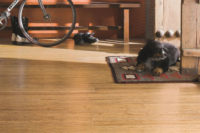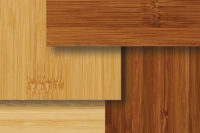Green: Laminate
Laminate: Covered in Green from Start to Finish

It may look like some exotic, high-end wood floor but, in reality, it’s laminate, which utilizes fast-growing, rapidly renewable wood as opposed to cutting down a rare or illegal species.

One of the many green advantages to laminate is the visual is actually a high-definition photograph protected with a durable wearlayer, allowing manufacturers to create products that mimic other materials such as tile.

Dan Natkin is director of hardwood and laminate at Mannington Mills and also serves as CFO and marketing committee chair for the North American Laminate Flooring Association (NALFA). Formed in 1997 by U.S. and Canadian manufacturers and importers of laminate flooring NALFA has been dedicated to creating voluntary product performance standards for laminate flooring in North America. For more information, call (202) 785-9500 or visit nalfa.com.



It is no secret that laminate flooring is inherently green. It has been touted as such for years by the industry, but what is so environmentally friendly about laminate? Well, just about everything.
Laminate is a fascinating product because it is environmentally friendly from start to finish—from its composition to installation to maintenance. It is a quality, durable product that is easy on your conscious.
Here are some reasons why and ways in which you can speak to your customers about it:
Laminate is made from a high-recycled content core that is rapidly renewable.The core material in laminate flooring is comprised of fast growth and/or in many cases recycled wood material.
These materials comprise upward of 70% recycled components including pre-consumer wood waste. Reusing this waste keeps it out of the landfill or from being burned and affecting air quality. And, some members of the North American Laminate Flooring Association (NALFA) also use excess material as a heat or power source thereby further reducing the environmental impact.
Laminate is bio-based and recyclable. As already noted, the majority of the composition of laminate is wood fiber, a renewable and bio-based raw material.
Unlike other flooring types, which rely primarily on petro chemicals, laminate uses an almost infinitely renewable resource. Add to this the fact that when you replace a laminate floor, it can be recycled with other wood fiber based products.
Some consumers actually reuse their laminate floors when they move homes by simply taking their floor with them. This is virtually impossible with any other type of floor covering.
No rare or exotic species are used in production. Laminate simply creates the look of a natural resource—such as wood or stone—as opposed to actually using it. Many laminate manufacturers, especially those who are NALFA members use state-of-the-art graphics to reproduce a wide range of looks from exotic woods to rare or extinct species, to more common types like maple.
Laminate flooring’s appearance is actually a high-definition photograph, which is protected with a durable wearlayer, so it can provide the desired look without the sacrifice of a natural resource.
Laminate design is with water-based, low VOC ink. Many of NALFA’s manufacturing members, as well as other makers of laminate, use water-based, low VOC (volatile organic compound) inks in the design of the laminate product.
These inks are safer for consumers and the environment, compared to solvent based inks.
No harmful glues are used for installing laminate floors. Today there are numerous mechanical locking systems available. Some of these are proprietary to a particular manufacturer while others can be licensed to a company for a fee. In many cases, these locking systems are protected by U.S. and international patents due to their ingenuity in design, which is why a licensing fee is required to use them.
The locking systems, which are built into the laminate flooring planks, eliminate the introduction of VOCs into the indoor environment because no adhesives are needed to install the product.
Responsible packaging. Many manufacturers, especially those who are NALFA members, use recycled materials for the packaging their laminate products.
No harsh chemicals are needed for cleaning and maintaining laminate floors. Cleaning and maintaining a laminate floor is one of the easiest things a consumer can do as no harsh chemicals are needed. Simply sweeping and light mopping will keep the floors looking great for many years.
In addition, laminate floors do not need to be refinished, therefore reducing any VOCs that may be in finishes.
Laminate floors are long lasting. Laminate floors are very durable, which reduces the need for replacement. And, with the easy locking systems the floors can be removed and reused in another part of the home or even donated to your favorite charity.
In fact, several manufacturers encourage the re-use of their products in residential settings.
Green association recognition. Laminate flooring in general, but especially those from NALFA members, as well as the factories in which the products are produced are recognized by many third-party green certifications, including, but not limited to such ones as FloorScore, a well-known indoor air quality rating system for hard surface flooring products; GreenGuard, another well-known rating system that covers a broad expanse of products, including flooring; ISO 14001 - Environmental Management System, which addresses various aspects of environmental management; Programme for the Endorsement of Forest Certification (PEFC), an international non-profit, non-governmental organization dedicated to promoting sustainable forest management through independent third-party certification, and Nordic Ecolabel, also known as Green Swan, which was established in 1989 by the Nordic Council of Ministers, and is the official Ecolabel of the Nordic countries where many laminate manufacturers are headquartered.
All NALFA certified products are CARB 2 compliant. NALFA production meets requirements set forth by the California Air Resources Board (CARB). And because laminate is made of recycled components, as well as the many other environmental aspects noted, laminate floors help home and business owners meet standards set forth by the U.S. Green Building Council’s Leadership in Energy and Environmental Design (LEED) rating systems.
Looking for a reprint of this article?
From high-res PDFs to custom plaques, order your copy today!








